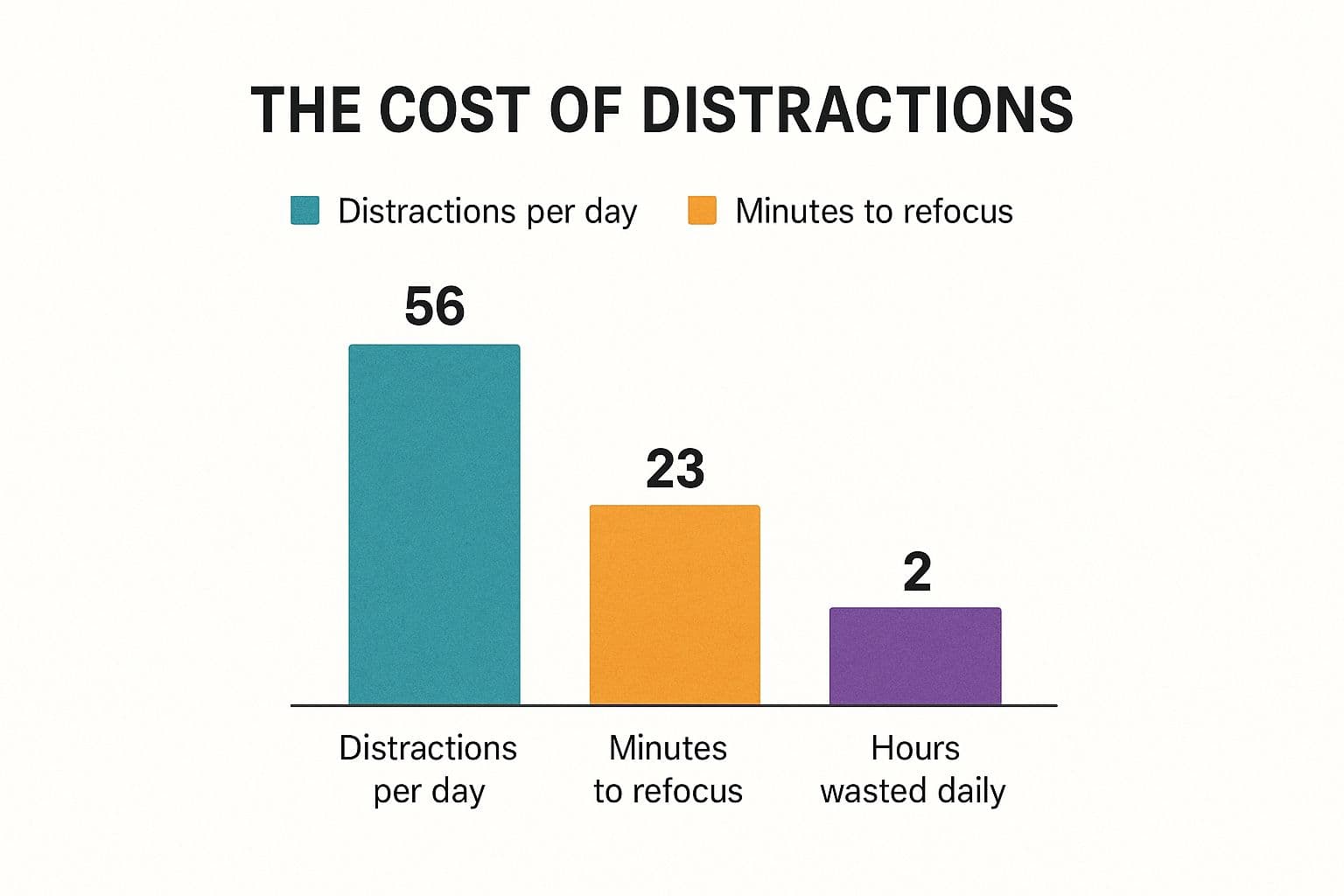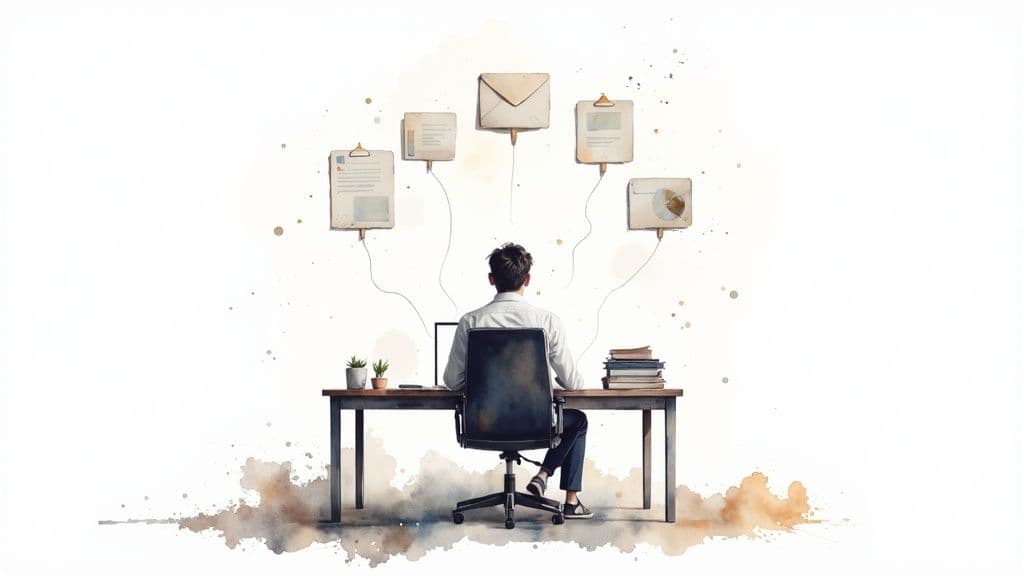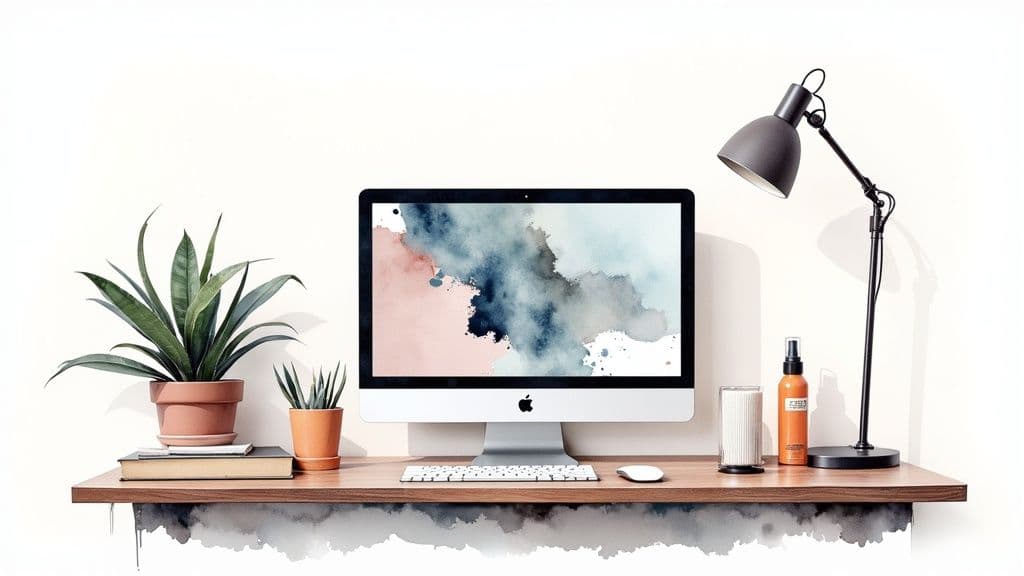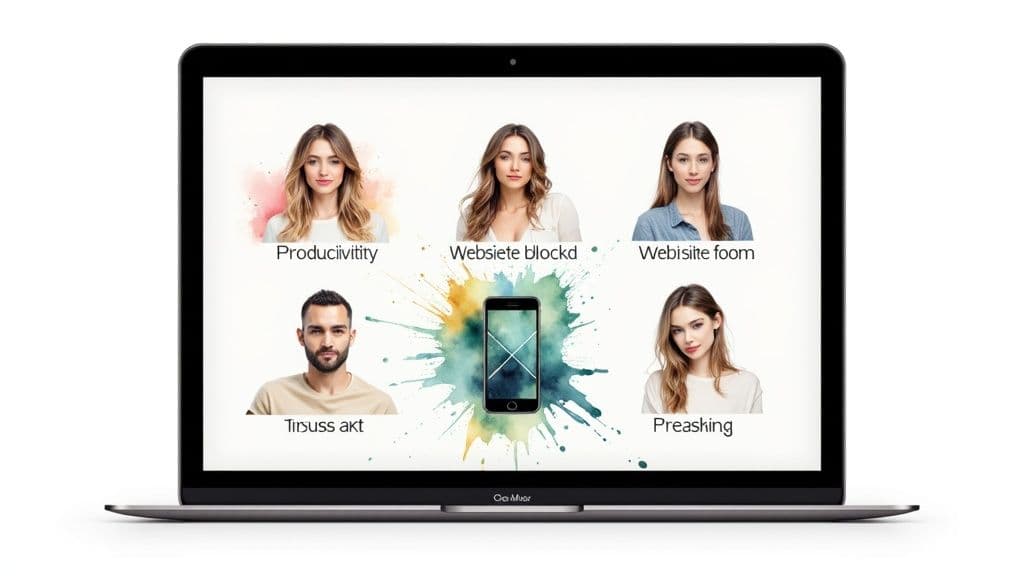Learn how to avoid distractions at work with proven strategies. Boost your productivity and reclaim your focus with practical tips for the modern workplace.
June 28, 2025 (6mo ago)
How to Avoid Distractions at Work and Stay Focused
Learn how to avoid distractions at work with proven strategies. Boost your productivity and reclaim your focus with practical tips for the modern workplace.
← Back to blog
Learning how to focus at work is a skill, and like any skill, it requires a smart approach. It’s not just about gritting your teeth and trying harder. You have to tackle both the external pings and interruptions and the internal pull of your own thoughts.
The real secret is to combine a few key things: optimizing your physical and digital spaces, building better work habits, and setting clear boundaries with your colleagues. It's less about raw willpower and more about creating a personal system where focus becomes the path of least resistance.
The True Cost of Workplace Distractions
Before we get into the "how-to," let's talk about why this matters so much. A random Slack message or a "quick question" from a teammate might seem like no big deal. But they add up. Fast. These tiny moments of broken concentration are like productivity leaks, draining your energy, creativity, and even your job satisfaction.
When you zoom out, the scale of the problem is staggering. According to a Gallup report on the global workplace, employee disengagement—often fueled by constant interruptions—costs the global economy an estimated $438 billion** every year. That number makes it crystal clear: this isn't just a personal pet peeve, it's a massive business problem.
The Daily Toll of Interruptions
Think about a typical day. It often feels like you’re fighting a constant battle for your own attention. Every time you get pulled away from what you’re doing, you don't just lose the few minutes of the interruption itself. You lose the much longer stretch of time it takes to actually get your head back in the game.
To put this into perspective, let's look at how these seemingly small interruptions stack up over a single day.
The Daily Toll of Common Workplace Distractions
| Distraction Type | Frequency of Occurrence | Average Refocus Time |
|---|---|---|
| Email Notifications | Up to 121 times per day | 64 seconds |
| Social Media Checks | Up to 32 times per day | 15 minutes |
| "Quick Questions" from Colleagues | 50-60 times per day | 23 minutes |
| Smartphone Alerts | Up to 60 times per day | 20 minutes |
The data paints a pretty stark picture. These interruptions aren't just minor annoyances; they are significant roadblocks to getting meaningful work done.
This constant switching leaves behind what experts call "attention residue," where part of your brain is still stuck on the last thing you were doing. It’s the enemy of deep work—that state of flow where your best, most innovative thinking happens.

With dozens of distractions and a surprisingly long refocus time for each, it's easy to see how hours of productive time can simply vanish every single day.
Moving Beyond Personal Willpower
It's crucial to look at this problem differently. If you're struggling to stay focused, it's not a personal failure or a sign of weak willpower. More often than not, it's a natural reaction to a work culture that celebrates constant availability over concentrated effort.
The key is to stop blaming yourself and start designing a better workflow. When you reframe the challenge this way, the goal becomes creating a system that protects your focus, making it easier to find and maintain.
Understanding this is the first real step toward taking back your workday. By putting a few smart, practical strategies in place, you can transform your day from a reactive, fragmented mess into one that feels proactive, productive, and a whole lot less stressful.
Taming Your Tech: How to Set Up a Digital Fortress for Deep Work

Let's be honest: our devices can be our greatest ally or our worst enemy when it comes to getting things done. The real difference-maker is who's in charge—you or the constant pings? To truly shield yourself from distractions, you need to go beyond just hitting the mute button. It's time to actively redesign your digital workspace so it serves your focus, not fractures it.
Think about it. The modern digital world is practically built to steal our attention. Research has shown that office workers check their email about 36 times an hour and then need an average of 16 minutes to get back on track after each interruption. That constant digital pull shatters the workday into tiny, unproductive pieces, making deep concentration feel like an impossible goal.
Fine-Tune Your Tools for Focus
Start with the apps you live in every day: Slack, Microsoft Teams, your email client. The key isn't to go dark, but to control the flow of information on your own terms. Instead of blanket-muting everything, get surgical with your notification settings.
In Slack, for example, you can set up custom keyword alerts. This is a game-changer. You can mute a noisy channel but still get a ping if someone mentions your name, a project you're leading, or an urgent term like "UAT-issue." Suddenly, the firehose of chatter becomes a manageable stream of only what you need to know.
The same logic applies to email. Set up filters to automatically sort messages. Newsletters, routine CC's, and automated reports can be routed away from your main inbox, ready for you to batch-process when you decide it's time.
Build Your Digital Fortress with Focus Modes
Most operating systems now have incredibly useful "Focus Mode" or "Do Not Disturb" features built right in. These are your best friends in the fight against random interruptions. But don't just flip on the generic setting. I've found the most success by creating custom profiles for different kinds of work.
For anyone serious about productivity, a "Deep Work" focus mode is non-negotiable. It's designed to create an impenetrable digital space where you can truly concentrate, blocking everything except the absolute essentials.
Here’s how you can configure a powerful focus mode:
- Block distracting websites: Proactively add social media, news sites, and personal email domains to a blocklist.
- Silence non-essential apps: Only allow the specific software you need for the task at hand to send you notifications.
- Limit contacts: Set it so only your manager or a direct report can break through with a call or text for a genuine emergency.
This strategy is incredibly effective when paired with time-blocking—scheduling these focus sessions right into your calendar. A well-built digital fortress is how you stop reacting and start concentrating.
Of course, knowing what to work on during these protected blocks is just as crucial. If you need a hand with that, check out our guide on powerful task prioritization techniques to ensure you're always tackling the most impactful work. It's this kind of disciplined approach that helps you finally produce your best results.
Designing a Workspace That Defeats Distractions

While getting a handle on your digital habits is a big part of the battle, don't underestimate the power of your physical surroundings. Your desk, your chair, and even what’s in your line of sight can either pull you into deep work or push you toward distraction. If you’re serious about learning how to avoid distractions at work, you have to get intentional about your space.
This isn’t about needing a corner office with a view. It’s about making smart choices with what you’ve got, whether that's a cubicle in a noisy open office or a makeshift desk in your living room. The goal is to consciously build your own little productivity sanctuary.
Taming the Open Office Environment
Let's be honest: the modern open office can be a nightmare for concentration. Between the constant motion, the sea of background conversations, and the friendly "drive-by" questions, finding an uninterrupted hour can feel like a miracle. But you can carve out your own pocket of focus with a few tactical adjustments.
Your position is your first line of defense. If you have any say in the matter, try to set up your desk so your back is to a wall or at least facing away from high-traffic zones. Simply not facing the main walkway drastically cuts down on the visual noise that constantly pulls at your attention. You'll be far less likely to get pulled into conversations just because you made eye contact.
Next, send clear signals. A good pair of noise-canceling headphones is the universal symbol for "do not disturb." It does more than just muffle the sales team's chatter; it’s a powerful visual cue that tells your colleagues you're deep in thought and shouldn't be interrupted for a quick question.
Building a focused workspace isn't about a massive overhaul. It's about a series of small, deliberate tweaks that make focus the path of least resistance.
Creating a Dedicated Home Office Space
When you work from home, the lines between your job and your life can get incredibly blurry, turning focus into a constant uphill battle. The most effective solution is to create a psychological boundary with a dedicated physical workspace. You don’t need a separate room—even a specific corner of a room can work wonders.
The golden rule is this: that space is exclusively for work. When you sit down at that desk, it's a signal to your brain that it’s time to get down to business. That means no eating lunch there, no scrolling Instagram, and no paying bills. The stronger you build that association, the easier it becomes to slip into a productive state of mind.
To really reinforce your focus zone, try these simple enhancements:
- A "do not disturb" sign: It might feel a little old-school, but a physical sign on your door or desk is surprisingly effective, especially when you share your space with family or roommates.
- A daily reset: A cluttered desk creates a cluttered mind. Take the last five minutes of your workday to tidy up. This simple ritual acts as a "closing ceremony," helping you mentally clock out and giving you a clean slate for the next morning.
- Good ergonomics: An uncomfortable chair or a monitor at the wrong height isn't just bad for your back; it's a nagging, low-level physical distraction. Investing in a decent setup that keeps you comfortable for hours is a direct investment in your ability to concentrate.
By putting real thought into your physical environment, you’re building an external support system for your internal focus, making it that much easier to do your best work.
Building Habits for Intentional Work
https://www.youtube.com/embed/yzd2q43A-6A
Silencing notifications and tidying your desk are great first steps, but they only solve half the problem. The most disruptive interruptions often come from inside our own heads—the stray thought, the sudden worry, or the nagging urge to check social media just one more time.
This is where the real work begins. Learning how to avoid distractions at work isn't just about controlling your environment; it's about building the mental scaffolding to support deep, sustained focus. It’s a shift from being reactive to being intentional, shaping your day instead of letting it shape you.
Schedule Your Focus with Time Blocking
One of the best ways I’ve found to protect my attention is time blocking. This goes way beyond a simple to-do list. It's the practice of assigning a specific job to every minute of your workday, right on your calendar. You schedule dedicated blocks for deep work, shallow tasks, meetings, and even breaks.
For instance, your calendar might have a block from 9:00 AM to 11:00 AM labeled "Deep Work: Q3 Report Analysis." You treat this like an unbreakable appointment with yourself. During that time, you do nothing else. This simple act eliminates the constant, draining question of "What should I do next?"—which is exactly when procrastination loves to sneak in.
A full calendar can look overwhelming at first glance, but it’s actually freeing. It cuts out the decision fatigue, letting you pour all your mental energy into the task at hand instead of wasting it on figuring out what's next.
This approach gives your work a clear structure and a sense of purpose. You're no longer just hoping to find time for your big projects; you're actively carving out that time. If you want to dive deeper into this and other focus strategies, we have more tips on how to stay focused at work.
Train Your Focus Muscle with The Pomodoro Technique
If a two-hour deep work session sounds like a marathon you’re not ready for, start with a sprint. The Pomodoro Technique is a fantastic time management method that helps build your focus endurance in short, manageable bursts. It’s perfect for training an easily distracted mind.
Here’s how it works:
- Pick one single task. Just one.
- Set a timer for 25 minutes and give that task your undivided attention.
- When the timer goes off, stop and take a genuine 5-minute break. Step away from your desk.
- After four of these cycles (or "Pomodoros"), take a longer break of 15-30 minutes.
Each 25-minute interval is a small win, teaching your brain that it can sustain attention. The built-in breaks are key—they fight off mental fatigue and make it easier to dive back in with fresh energy. It almost gamifies your workflow, making it much harder to procrastinate when you only have to commit to a 25-minute chunk of time.
Align Your Work with Your Energy
Let's be honest: not all hours are created equal. We all have natural rhythms. There are times when you feel sharp, creative, and ready to solve the world's problems, and other times when just clearing out your inbox feels like a monumental effort. The final piece of the puzzle is to work with these cycles, not against them.
Start by paying attention to your energy levels for a week. Are you a morning person who does their best thinking before noon? Or do you hit your creative peak in the late afternoon? Once you’ve identified your peak productivity hours, protect them at all costs.
Schedule your most demanding, high-concentration work—the stuff you're tempted to put off—during these prime windows. Save the low-energy admin tasks, like organizing files or responding to non-urgent emails, for your natural slumps. When you sync your tasks with your body’s internal clock, you’ll find that progress feels less like an uphill battle and more like you're riding a wave.
5. Get Your Team on Board by Communicating Boundaries

Let's be real: you can't protect your focus in a vacuum. Even with the perfect desk setup and iron-clad personal habits, you're still part of a team. If you don't get your colleagues on board, their "quick questions" and last-minute requests will constantly derail your best efforts.
The trick is learning how to communicate your boundaries clearly, respectfully, and—most importantly—proactively. This isn't about building a wall around your desk or being uncooperative. It’s about creating a shared understanding that focused time is a precious resource for everyone.
When you lead the way, you help build a culture where everyone’s concentration is valued. It starts with being upfront about what you're doing and why. Don't just vanish; signal your intentions.
Make Your Focus Time Visible
One of the simplest ways to head off interruptions is to make your focus periods obvious to your team. Most of the collaboration tools we use every day have features built for this exact purpose. Use them.
- Set a “Do Not Disturb” Status: In tools like Slack or Microsoft Teams, don't just let the default "away" status kick in. Actively change your status to something clear and specific, like "Deep Work until 2 PM" or "Focusing on Q3 report — message for urgent needs only." This is your digital "do not disturb" sign.
- Block It Out on Your Calendar: Schedule your focus sessions directly on your shared work calendar and mark yourself as "Busy." This is a game-changer. It not only prevents people from booking meetings over your most valuable hours but also gives them a quick visual cue that you’re unavailable.
This isn't about shutting people out. It's about framing your focus as a scheduled, important task—one that ultimately benefits the team through higher-quality work from you.
Have a Plan for Handling Interruptions
Even with the best-laid plans, interruptions will happen. That tap on the shoulder or the dreaded, "Got a quick sec?" can instantly shatter an hour of deep thinking.
Your best defense is a polite but firm script that allows you to defer the request without creating tension.
The most effective response I've found is one that acknowledges the person's request while firmly protecting your current focus block. Try something like this: "I'm right in the middle of something, but I can definitely help. Can I swing by your desk or ping you in about 45 minutes?"
This little script does two powerful things. First, it validates their need, showing them you're a team player. Second, it gently reinforces that your focused time is non-negotiable, training colleagues to check your status or calendar first.
Over time, this helps shift the entire team toward a more asynchronous style of communication, where an instant response isn't the default expectation. This is a huge step in learning how to avoid distractions at work, as it fosters a more thoughtful and genuinely productive environment for everyone.
Answering Your Toughest Questions About Workplace Distractions
Putting a plan in place to block out distractions is a great first step. But what happens when reality gets in the way? We all run into roadblocks when trying to build better habits. Let’s walk through some of the most common hurdles I’ve seen people face—and how you can navigate them.
"What if something actually urgent comes up while I'm in a focus block?"
This is probably the number one concern I hear, especially from people working in fast-moving teams. The fear of missing a genuine crisis is real.
The key is to get ahead of it by defining what "urgent" really means with your team. Is a server being down urgent? Absolutely. Is a question about a report due next Friday urgent? Not so much. Getting everyone on the same page is a game-changer.
Once you have that definition, set up a specific "break-glass" communication channel for true emergencies only—like a direct phone call. For everything else, you can confidently let your colleagues know you’ll get back to them once your dedicated work time is over.
This isn't about ignoring your team; it's about creating a system of mutual respect for everyone's focus. It trains people to pause and consider the real priority, while still leaving a clear path for genuine emergencies to reach you.
You can then sink into deep work with peace of mind, knowing that only a true fire will pull you out.
"My boss expects me to be online and available all the time. What can I do?"
This is a delicate one. Directly confronting a manager’s expectation of constant availability rarely goes well. Instead of focusing the conversation on your availability, shift it to your results.
Many managers haven't considered how the "always-on" culture quietly sabotages productivity. So, you have to show them.
Propose a small experiment. Ask for a trial run of just one or two weeks where you can implement dedicated focus blocks. Frame it as a way to improve the quality of your work and deliver projects more efficiently. Then, you have to follow through and deliver exceptional results during that time.
When you can point to a project you finished ahead of schedule or a report that was more thorough because you had uninterrupted time, you’re no longer asking for a favor. You're presenting a business case for a better way of working that makes you a more valuable employee.
"Forget my coworkers—I'm my own worst distraction! How do I handle my own wandering thoughts?"
Welcome to the club. Internal distractions can be even more persistent than a ringing phone because you can't just put your brain on silent.
The best tool I've found for this is surprisingly low-tech: a "distraction pad."
Keep a physical notepad or a simple digital text file on your screen. The moment a random thought, an unrelated idea, or a new to-do item pops into your head, just write it down. Don't engage with it, don't analyze it, just get it out of your mind and onto the page.
This simple act is incredibly powerful. It does two things:
- It reassures your brain that the thought won't be forgotten, so it can stop nagging you.
- It gives you permission to let the thought go and immediately refocus on your primary task.
You’re essentially telling your brain, "Got it. We’ll handle that later." It’s a simple trick that stops a fleeting thought from spiraling into a 20-minute detour.
Ready to build a system that manages tasks and protects your focus? Fluidwave combines intelligent task prioritization with delegation to skilled virtual assistants, giving you the structure and support needed to defeat distractions for good. Discover how to reclaim your workday.
Focus on What Matters.
Experience lightning-fast task management with AI-powered workflows. Our automation helps busy professionals save 4+ hours weekly.